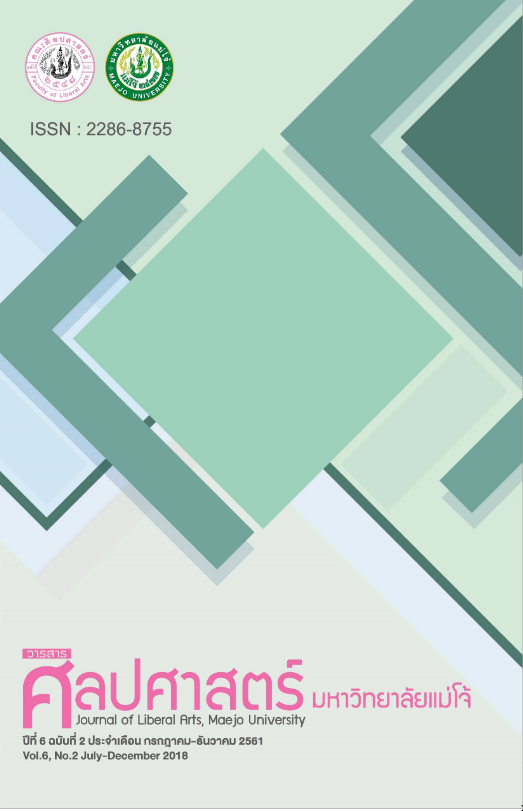การปรับปรุงข้อผิดพลาดทางการแปลจากภาษาไทยเป็นภาษาอังกฤษของนักศึกษาหลักสูตรภาษาอังกฤษ ชั้นปีที่ 3 คณะศิลปศาสตร์ มหาวิทยาลัยแม่โจ้ โดยใช้แบบฝึกหัดการหาข้อผิดพลาดทางไวยกรณ์ (Error IdentificationThe Improvement of Translation Mistakes of Maejo University’s English Major Students by Implementing Error Identification Exercises)
Main Article Content
Abstract
This study was conducted to find the student’s grammatical mistakes in translation exercises and to study the appropriate teaching by using the error identification exercises as a tool to develop translation skill of target students. The participants of this study are 69 English major students, Maejo University who registered for LE314 Translation 2 in academic year 2016.
The research methodology was done by using a translation pre-test and post-test including the error identification exercises as the research tools in order to locate grammatical mistakes during translation tasks. For the error identification, it was used as a treatment for correcting those mistakes.
According to the study, after the participants did a translation pre-test, it could be clearly seen that subject-verb agreement was a major mistake which was 44.36 percent. Then, four treatments were introduced by giving the error identification exercises to the participants each week and the teacher (researcher) gave an answer and explained the correct grammar rules at the end of the class. Afterwards, the participants were asked to do the translation post-test with an aim to compare the before-after mistakes. The result showed that the proportion of subject-verb agreement mistakes became lower which was only 31.70 percent followed by other mistakes such as tenses, missing subject and wrong part of speech. From this point, it can be concluded that the error identification exercise takes a role in developing correct understanding of grammar usage which also influences the correct translating skill from Thai to English.
Article Details
References
มหาวิทยาลัยเทคโนโลยีราชมงคลพระนคร (รายงานผลการวิจัย). กรุงเทพ: มหาวิทยาลัยเทคโนโลยีราชมงคลพระนคร.
นงพงา ประกิ่ง. (2557). การวิเคราะห์ข้อผิดพลาดด้านไวยากรณ์ในประกาศภาษาอังกฤษออนไลน์: กรณีศึกษา บริษัทซิเลซติกา
(ประเทศไทย) (วิทยานิพนธ์ปริญญามหาบัณฑิต). ชลบุรี: มหาวิทยาลัยบูรพา.
ปิยวรรณ รุ่งวรพงศ์. (2557). ปัญหาการเขียนภาษาอังกฤษของนักศึกษาใหม่ : กรณีศึกษามหาวิทยาลัยสงขลานคริทร์ วิทยาเขต
ตรัง. วารสารมหาวิทยาลัยราชภัฏมหาสารคาม (มนุษยศาสตร์และสังคมศาสตร์). (8)3, 119-126.
ปรีมา มัลลิกะมาส. (2556). การแปลกับการสอนภาษาอังกฤษ (พิมพ์ครั้งที่ 3). กรุงเทพฯ:จุฬาลงกรณ์มหาวิทยาลัย.
พรชัย พรวิริยะกิจ, และวรินทร แดนดี. (2558). ข้อผิดพลาดในการแปลภาษาอังกฤษเป็นภาษาไทยของนักศึกษาสาขาวิชา
ภาษาอังกฤษเพื่อการสื่อสารสากล. วารสารสังคมศาสตร์. 4(2), 16-24.
สมบูรณ์ พจน์ประสาท. (2550). การวิเคราะห์ข้อผิดพลาดการแปลภาษาอังกฤษเป็นภาษาไทยและการแปลภาษาไทยเป็นภาษา
อังกฤษของนักเรียนชั้นมัธยมศึกษาปีที่ 6 (วิทยานิพนธ์ปริญญามหาบัณฑิต). กรุงเทพฯ: มหาวิทยาลัยศรีนครินทรวิโรฒ.
Chien, Chin-Wen. (2015). EFL Undergraduates’ Awareness of Translation Errors in Their Everyday Environment.
Journal of Language Teaching and Research. (6)1, 91-98.
Hourani (2008). An Analysis of the Common Grammatical Errors in the English Writing Made by 3rd Secondary
Male Students in the Eastern Coast of the UAE (Master’s thesis). Dubai: British University.
Nihae, Nur-ihsaan. & Chiramanee, Thanyapa. (2014). Multiple-choice and Error Recognition Tests: Effects of Test
Anxiety on Test Performance. International Journal of English Language Education. 2(2), 78-88.
Presada, Diana. & Badea, Mihaela. (2013). The Effectiveness of Error Analysis in Translation Classes: A Pilot
Study. Porta Linguarum, (22), 49-59.
Richards, Jack C. & Rodgers, Theodore S. (2014). Approaches and Methods in Language Teaching.UK:
Cambridge University Press.
Zafar, Ameena. (2016). Error analysis: a tool to improve English skills of undergraduate students. Procedia Social
and Behavioral Sciences. 217, 697-705.

